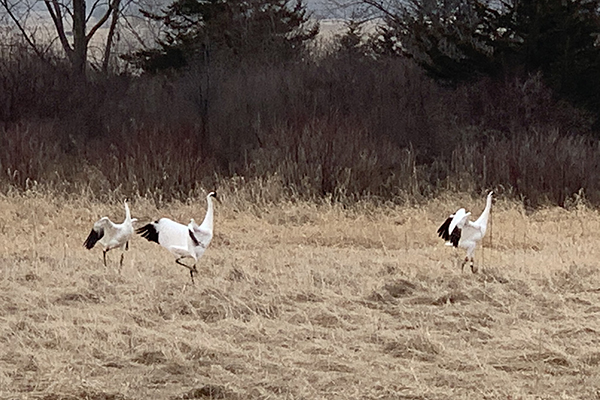
Last year, three Whooping Cranes chose to summer not far from the International Crane Foundation’s headquarters in Sauk County, Wisconsin. The three birds hatched in 2017. Two of the cranes, identified as 4-17 and 6-17, were reared by people in crane costumes at White River Marsh in central Wisconsin, and the third, 24-17, was raised by adult cranes at the Patuxent Wildlife Research Center in Maryland and released in Wisconsin his first fall. The first two birds, a male and a female, were associating together last summer with possible pair behavior. The third crane’s blood test indicated he was a male, but his behavior is more like that of a female crane. As winter neared and the three cranes left on migration, we wondered if this unusual trio would return next spring. We bet you can guess what happened!
I began observations on the recently returned birds in mid-March, prior to the “Safer at Home” initiative directed by Wisconsin’s Gov. Tony Evers. Following are my field notes from my patient observations of the birds over nearly a week between March 19 to 24, 2020. A veritable soap opera ensued during my observations, including territorial unison calls, chasing away encroaching Sandhill Cranes, nest building (plural) and so much more. I hope you enjoy spending this time in the field with me!
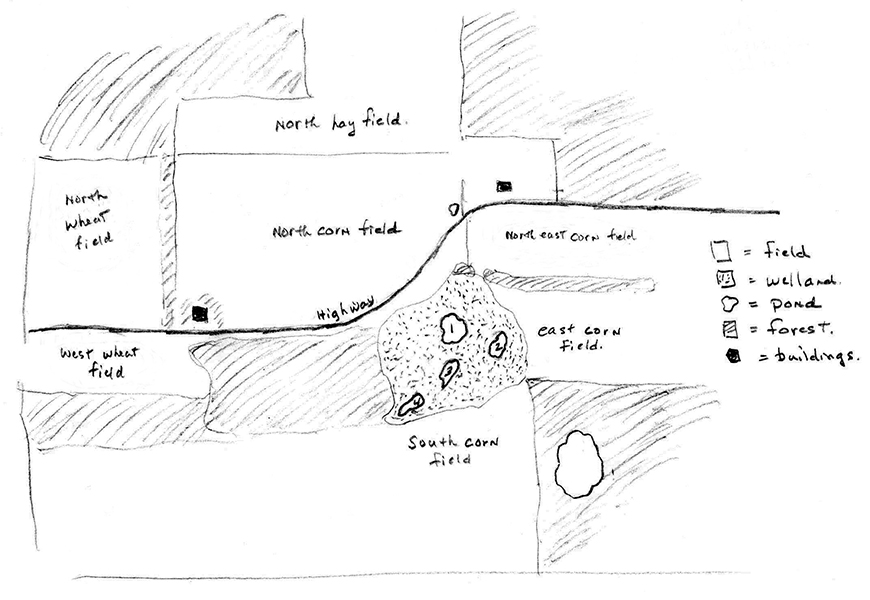
March 19. Foggy. Mild temperatures in the 40s.
It poured rain most of the morning, so I was unable to watch the cranes. I observed them from 11 a.m. to noon.
The Whooping Cranes spent most of the hour on the southwest side of the wetland, and unison called several times in response to the unison calls of a pair of Sandhill Cranes. At 11:21 a.m. they made a circle over the northwest part of their territory that included the wetland, the county road and the cornfields bordering the road on both sides. They landed in a cornfield west of the wetland, chased Sandhills, returned to the marsh and unison called. It’s interesting that they concentrated on excluding Sandhills from the northwest part of their territory. Perhaps the presence of a flock of about 40 Sandhills in the west cornfield led to this response.
March 20. Temperatures in the 20s. Chilly. 7 to8:27 a.m.
The Whooping Cranes were in the east and out of sight from the county road when I arrived.
At 7:02 a.m. they appeared in flight low over the wetland heading northwest toward my viewpoint, crossed the road and landed just north the neighbor’s residence. They must have observed the west pair of Sandhill Cranes flying in that direction. The Whooping Cranes landed beside the Sandhills. The latter took flight and were chased by the Whooping Cranes. The Sandhill Cranes must have landed in cornfields west of the marsh. The Whooping Cranes flew to the south-central part of the marsh and landed. At 7:04 a.m. 4-17 and 6-17 copulated and 24-17 stood nearby. After copulation 6-17 threat-walked toward 24-17, and the latter walked away a short distance, also in threat-walk. All three cranes preened until 7:14 a.m. Then they flew to the central area of open water of the marsh for a few minutes, after which they flew back to the south side of the marsh and preened some more. At 7:31 a.m. four Sandhill Cranes flew over the Whooping Cranes, and the latter unison called at them.
The ponds in the wetland seem filled with Canada geese. The Whooping Cranes ignore them. However, it’s quite a different story for Sandhill Cranes. Sometimes the trio unison calls. At other times, 4-17 elevates his humeri and tertial feathers and drops his black primary feathers vertically – a threat display using his wings and feathers – as Sandhill Cranes fly nearby.
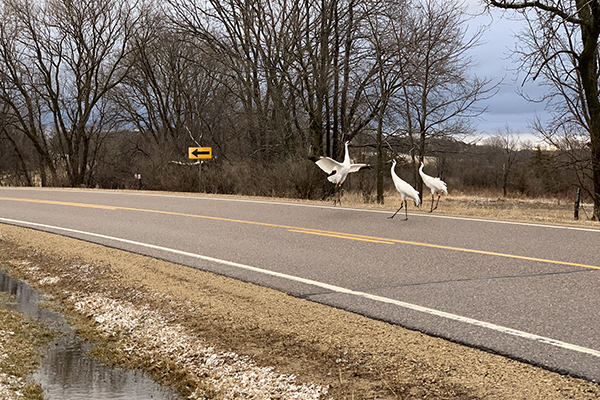
At 7:38 a.m. they flew to the north cornfield and landed near the neighbor’s barn. 6-17 threat-walked and lunged at 24-17. Then they relaxed and picked corn, gleaning among the stubble. At 7:48 a.m. 4-17 and 6-17 copulated again in the cornfield. Then they walked across the road to a field where the crops had been harvested, leaving a bare field where it appeared easy for the Whooping Cranes to find earthworms. They again walked across the road and up, meeting the pavement and danced a bit before continuing to feed on corn on the other side of the road. It appeared the smooth firm road provided a better substrate for dancing than the muddy fields. They fed on corn for a few moments and then flew back to the marsh and chased Sandhill Cranes. 24-17 made a long solo flight chasing the Sandhill Cranes and then returned and landed beside the pair of Whooping Cranes.
8:18 a.m. Sixteen Sandhill Cranes landed in the cornfield south of the marsh. The Whooping Cranes unison called but did not chase them. Chasing appeared dedicated to the two pairs of Sandhills – one in the east end of the wetland and the other in the west end. In 2019, a Sandhill pair in the east fledged one chick, and a pair in the west fledged two. Likely these same pairs have returned to establish their breeding territories. They frequently respond to one another’s unison calls.
8:27 Forty-two more Sandhills join the flock on the south cornfield.
I returned at 6:58 p.m. The Whooping Cranes were in the central part of the wetland. 6-17 solicited for copulation with wings stiffly extended and 4-17 approached her calling loudly. He did not mount her. 6-17 and 24-17 started dancing. Then 6-17 lunged at 24-17. There were more than 100 Sandhills in the south cornfield. They flew northeast in small groups presumably to traditional roosting areas on sandy islands in the nearby Wisconsin River.
At 7:04 p.m. the Whooping Cranes flew to the cornfield east of the wetland and foraged. At 7:11 p.m. they returned to the wetland and searched for food in the wetland, showily walking and probing. 24-17 walked toward a flock of Sandhill Cranes.
At 7:20 p.m. the three Whooping Cranes were with many geese in the central pond of the wetland. 24-17 is perhaps 20 feet from the pair. Usually, she is closer.
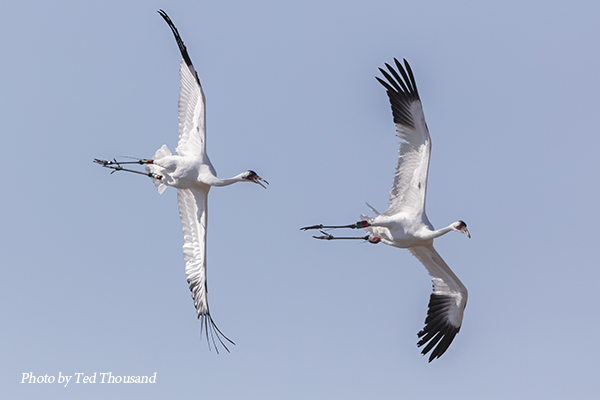
March 21. Very cold. The ponds are frozen.
6:50 a.m. The Whooping Cranes are standing on the ice in the central pond while the west pair of Sandhill Cranes flies from the marsh to the north cornfield beside the county road. The east pair of Sandhills give unison calls and the Whooping Cranes follow likewise.
6:54 a.m. The Whooping Cranes fly to the north cornfield and cause the pair of Sandhills to fly south toward the marsh. As the Sandhills fly the Whooping Cranes unison call and then eat corn.
7 a.m. 6-17 solicits for copulation, 4-17 approaches but does not mount. Then they feed again.
At 7:10 a.m. 6-17 and 4-17 have a complete copulation.
At 7:18 a.m. the west pair of Sandhill Cranes return to the field and the Whooping Cranes approach them. 4-17 walks behind them and threat-walks, and the Sandhill Cranes and 4-17 disappear behind a building and tree on the neighbor’s farm. Silence prevails and some minutes later 4-17 returns to rejoin the Whooping Cranes. I walk west along the road to have a look. The Sandhill Cranes stand on the lawn between the house and the road. Apparently, 4-17 was reluctant to venture so close to human habitation. At 7:25 a.m. the Whooping Cranes fly south to the wetland and preen and rest. Groups of Sandhill Cranes fly into the south cornfield in a group of 15, 13, 9 and 2. At 8:20 a.m. 6-17 and 24-17 chase Sandhill Cranes, then the trio of Whooping Cranes flies around the wetland chasing Sandhill Cranes and land in the central area.
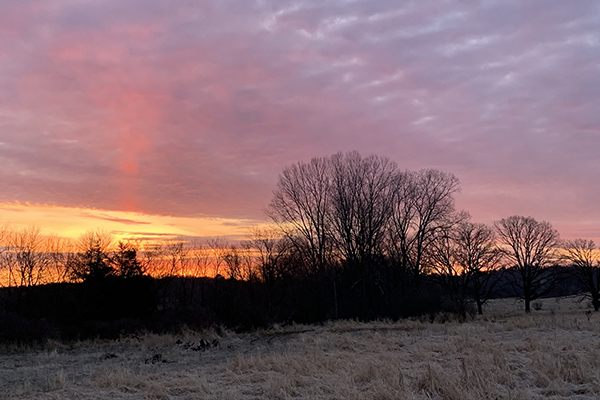
March 22. In the 30s.
6:37 a.m. Whooping Cranes are in the central area of the wetland. They unison call.
6:46 a.m. Incomplete copulation. 4-17 mounts the female and then dismounts forward over 6-17’s head. All three cranes engage in a vigorous dance followed by preening.
7:02 a.m. Sandhill Cranes Unison Call coming from both east and west sides of the wetland.
7:04 a.m. The west Sandhill pair calls again and the Whooping Cranes fly west and disappear from view. Then they return and fly to the west field. They chase a pair of Sandhills, and a single Sandhill Crane remains. It is submissive to the Whooping Cranes. 24-17 threat-walks toward the Sandhill Crane, then returns to the pair. The Sandhill Crane remains. It is perhaps an unpaired bird and therefore not a threat to the real estate of the Whooping Cranes.
7:15 a.m. The trio walks to the road and then flies to the north cornfield. 24-17 is threatening Sandhill Cranes some distance away. 4-17 and 6-17 ignore those Sandhill Cranes.
7:32. 30 Sandhill Cranes fly in from the north over the Whooping Cranes. The Whooping Cranes fly low and beneath them. The Sandhill Cranes land in the cornfield south of the marsh while the Whooping Cranes land in the center of the wetland.
7:40 to 7:50 a.m. A lone female Sandhill appears from the south high in the sky and with intervals of some seconds emits a high-pitched short shrill call. The bird circles the area seven times and then continues east. Perhaps this was an unpaired female soliciting availability for a lone male defending a territory of wetland and waiting for a potential mate to arrive. The wetland in question was already claimed by two pairs of Sandhill Cranes and a trio of Whooping Cranes.
A newly adult, unpaired male Sandhill Crane often returns to the area where it was fledged, or learned to fly, and tries to establish a territory near its parents. Sometimes the breeding territory of the parents is divided allowing their son real estate. In contrast, female cranes disperse many miles from the area where they were fledged. They perhaps search for lone males with a territory. I have frequently heard such lone Sandhill males calling their portion of the unison call when other Sandhills fly by. This perhaps communicates a message of exclusion to most cranes as well as one of invitation to lone females.
7:32 a.m. The Whooping Cranes stand in the central area of the wetland. They rest and preen.
8:03 a.m. Five Sandhill Cranes fly over the wetland and the Whooping Cranes unison call.
8:05 a.m. Three Sandhill Cranes fly over and Whooping Cranes unison call.
8:06 a.m. Whooping Cranes fly to the far north cornfield beyond the field that borders the road. They feed.
8:21 a.m. Suddenly the three Whooping Cranes fly west over a forest and land in another cornfield. They chase a pair of Sandhills from that field. Perhaps the Sandhill Cranes called and alerted the Whooping Cranes to their presence. The Sandhill Cranes are followed for a long distance by 24-17. She then returns to join the Whooping Cranes and together they forage.
8:28 a.m. The trio flies to the center of the marsh and unison calls.
I returned briefly at 5:30 p.m. and was amazed that all three Whooping Cranes were nest building in the pond in the center of the wetland. They all appeared to be throwing large clumps of mud into piles, one pile for 4-17 and 6-17, another pile for 24-17.
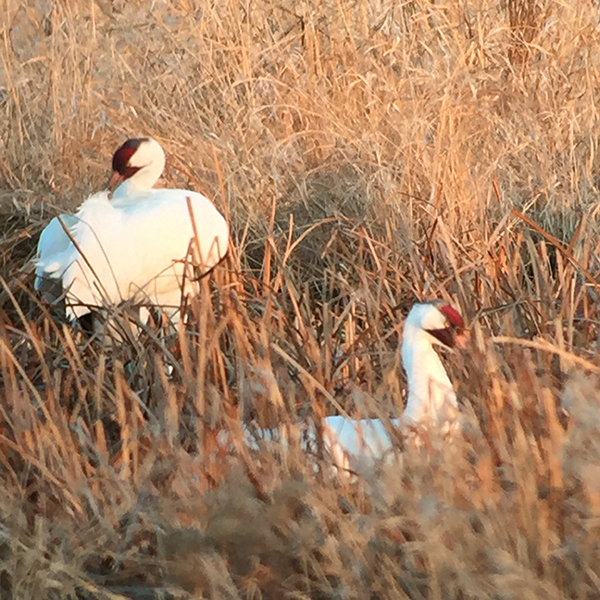
March 23
6:40 a.m. Whooping Cranes unison call from east of wetland. I cannot see them.
6:42 a.m. 24-17 chases a pair of Sandhill Cranes across the wetland and continues the chase to the west. Finally, she circles back to join the pair.
6:50 a.m. Whooping Cranes – trio unison call.
7:00 a.m. The three Whooping Cranes walk toward the pond in the center of the wetlands. Upon reaching the area where they were nest building the previous evening, they all start dancing. They continued walking to the west side of the wetland and then stopped and preened.
7:08 a.m. Failed copulation 4-17 and 6-17.
7:12 a.m. Pair of Sandhill Cranes unison call from the north side of the marsh, then they fly over the Whooping Cranes to the south cornfield. 4-17 elevates his wings and drops his primaries in threat.
7:15 a.m. Whooping Cranes fly to the cornfield north of the road and feed.
7:30 a.m. Whooping Cranes walk-fly across the road and the wetland and land in the east cornfield. They unison call and feed.
7:50 a.m. Whooping Cranes unison call as three Sandhill Cranes fly over.
8:05 a.m. Whooping Cranes fly to the south side of the cornfield that borders the south side of the road near the neighbor’s home. They forage in a drainage ditch. They walk slowly, searching and stop to probe into the mud a few times and then continue. They disappear around a bend in the ditch. Across the wetland, I observe a pair of Sandhills foraging in a cornfield. They do not appear to be feeding on corn, but rather they vigorously dig in the soil, perhaps for insects or worms. They often just pick kernels of unharvested corn in like manner to the Whooping Cranes. I have not observed the Whooping Cranes digging in the field like the Sandhills.
There are more than 100 Sandhills in the south cornfield. They are walking rather quickly toward the east side of the field and then appear to stop perhaps because of a fence. Then I observe a coyote running away from the cranes beyond where the flock stopped. They were clearly attracted to the potential danger and by watching the predator and walking towards it the predator was thwarted.
8:45 a.m. Whooping Cranes unison call from far east beyond a forest. I cannot see them.
8:46 a.m. Whooping Cranes appear back of the east cornfield not far from where I observed the coyote. Then they fly to the center of the wetland, unison call and chase a group of Sandhill Cranes from the wetland.
8:50 a.m. Whooping Cranes walk back to the pond where they had built nests the previous evening. They dance a bit and then unison call as some Sandhill Cranes fly overhead.
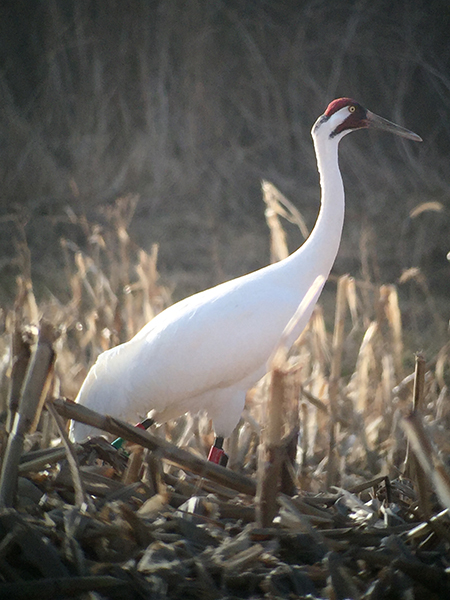
March 24. Mild 30s, high fog
6:45 a.m. Whooping Cranes at the end of the wetland, could not see them from the parking spot. Whooping Cranes unison call. One pair of Sandhill Cranes guard calls is southwest of the wetland.
6:52 a.m. Lone male Sandhill Crane calls loudly (solo unison call) from north of north cornfield that borders the road. Whooping Cranes unison call.
6:52 a.m. Whooping Cranes fly to the area where lone male Sandhill Crane was calling, the male must have departed. The Whooping Cranes are on the hayfield north of the cornfield. Sandhill Cranes in southwest marsh fly to west cornfields.
6:56 a.m. Whooping Cranes feeding in hayfield, slowly walking looking at the ground then suddenly poking at the ground and sometimes grabbing what appears to be earthworms. They do not forage in the nearby cornfield.
6:59 a.m. Complete copulation of 4-17 and 6-17 in the hayfield. After dismounting, 4-17 does an open wing back threat and 6-17 and 24-17 walk in threat posture to the left. No unison call or fighting. Then they continue feeding. When they hear Sandhill Crane calling from the marsh they stop walking and assume alert posture.
7:19 a.m. Sandhill Crane unison call from a pair near neighbor’s shed. Whooping Cranes fly from hayfield to northwest corner of cornfield across from the shed. Lone male Sandhill Crane across the road in the cornfield. Whooping Cranes walk there and then chase him toward wetland.
7:24 a.m. A large flock of Sandhill Cranes arrives from north and land in the south cornfield, about 40 cranes. Small groups of Sandhill Cranes continue to arrive.
7:26 a.m. Pair of Sandhills from west marsh fly to cornfield beside the road, as they do Whooping Cranes unison call from east of marsh. Then I notice 6-17 in the middle of the marsh. Gradually the 24-17 and 4-17 walk from the east towards the pond in the marsh as does the 6-17.
6-17 separated from the others and went to the center of the wetland and then to the pond where they had constructed a nest. This was the first time I ever observed her leave 4-17. While she was away, 4-17 was with 24-17.
8:06 a.m. More Sandhill Cranes arrive in flocks of 15, 16 and land in the south cornfield.
8:11 a.m. Whooping Cranes fly to the east cornfield.
8:21 a.m. Whooping Cranes fly and land in the wetland field just in front of me. There are no Sandhill Cranes around. Then they walk to the ditch. Where the ditch bends east, 24-17 and 4-17 seemed to be eating aquatic vegetation from the water in the ditch. Then the three cranes walk along the ditch until the opening through the wood. The enter the opening and I can no longer see them.
8:50 a.m. The Whooping Cranes are hidden by the forest. Seven Sandhill Cranes fly over and the Whooping Cranes emit a prolonged unison call. Now more than 100 Sandhill Cranes have moved from the south cornfield into the southeast corner of the wetland. They are silent and resting.
8:58 a.m. Whooping Cranes fly from the east of north cornfield and chase a pair of Sandhill Cranes. The Whooping Cranes fly after them into the marsh and continue to chase them to the west.
9:05 a.m. The Whooping Cranes fly back to the east cornfield.
 Story submitted by George Archibald, Co-founder and Senior Conservationist. Click here to learn more about our work in North America.
Story submitted by George Archibald, Co-founder and Senior Conservationist. Click here to learn more about our work in North America.
